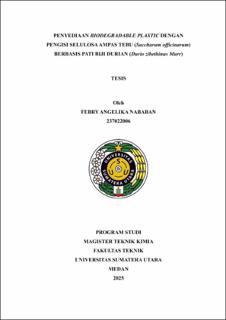| dc.contributor.advisor | Nasution, Halimatuddahliana | |
| dc.contributor.advisor | Masyithah, Zuhrina | |
| dc.contributor.author | Nababan, Febry Angelika | |
| dc.date.accessioned | 2025-07-24T04:15:27Z | |
| dc.date.available | 2025-07-24T04:15:27Z | |
| dc.date.issued | 2025 | |
| dc.identifier.uri | https://repositori.usu.ac.id/handle/123456789/106925 | |
| dc.description.abstract | This study aims to determine the effect of adding bagasse cellulose as a filler to durian seed starch-based bioplastics and to determine the best bagasse cellulose formulation for improving the characteristics, physical properties, mechanical properties, and biodegradability of the resulting bioplastics. In this study, sugarcane bagasse was hydrolyzed with sulfuric acid (H2SO4) at varying concentrations of 50%, 40%, and 30%. The starch used in this study was obtained from the extraction process of durian seeds. The casting method was used in the production of bioplastics based on durian seed starch with the addition of sugarcane bagasse cellulose as a filler at 0-12% (%b) and glycerol at 30% as a plasticizer (%b). The yield of durian seed starch was 16.06%. The yield of sugarcane bagasse cellulose decreased with increasing H2SO4 concentration, with the highest yield at 30% H2SO4 concentration (49.2%). XRD testing showed the highest crystallinity index was obtained at 40% H2SO4 concentration (91.68%). PSA test results showed the particle size distribution of sugarcane bagasse cellulose at a 40% H2SO4 concentration of 381.87 nm. FTIR analysis results confirmed the presence of starch and cellulose groups in the produced bioplastic. The highest bioplastic density was 0.933 g/mL in bioplastic filled with 6% sugarcane bagasse cellulose. The water absorption capacity of bioplastic filled with 6% sugarcane bagasse cellulose was 92.43%. The highest tensile strength was obtained by bioplastic with 6% sugarcane bagasse cellulose filler at 2.33 MPa. Increasing the filler content increased the tensile strength, supported by SEM test results showing a denser, non-porous, and non-cracked bioplastic surface. The highest elongation at break value was obtained by bioplastic with 12% sugarcane bagasse cellulose filler, at 20.46%. Based on the biodegradation test results, the degradation ability of bioplastic using the soil burial test method was higher than that of the open-air test method. | en_US |
| dc.language.iso | id | en_US |
| dc.publisher | Universitas Sumatera Utara | en_US |
| dc.subject | durian seeds | en_US |
| dc.subject | sugarcane bagasse cellulose | en_US |
| dc.subject | glycerol | en_US |
| dc.subject | bioplastic | en_US |
| dc.subject | biodegradable | en_US |
| dc.title | Penyediaan Biodegradable Plastic dengan Pengisi Selulosa Ampas Tebu (Saccharum officinarum) Berbasis Pati Biji Durian (Durio zibethinus Murr) | en_US |
| dc.title.alternative | Production of Biodegradable Plastic with Sugarcane Bagasse Filler (Saccharum officinarum ) based on Durian Seed Starch (Durio zibethinus Murr) | en_US |
| dc.type | Thesis | en_US |
| dc.identifier.nim | NIM237022006 | |
| dc.identifier.nidn | NIDN0008047301 | |
| dc.identifier.nidn | NIDN0005097101 | |
| dc.identifier.kodeprodi | KODEPRODI24101#Teknik Kimia | |
| dc.description.pages | 108 Pages | en_US |
| dc.description.type | Tesis Magister | en_US |
| dc.subject.sdgs | SDGs 12. Responsible Consumption And Production | en_US |


